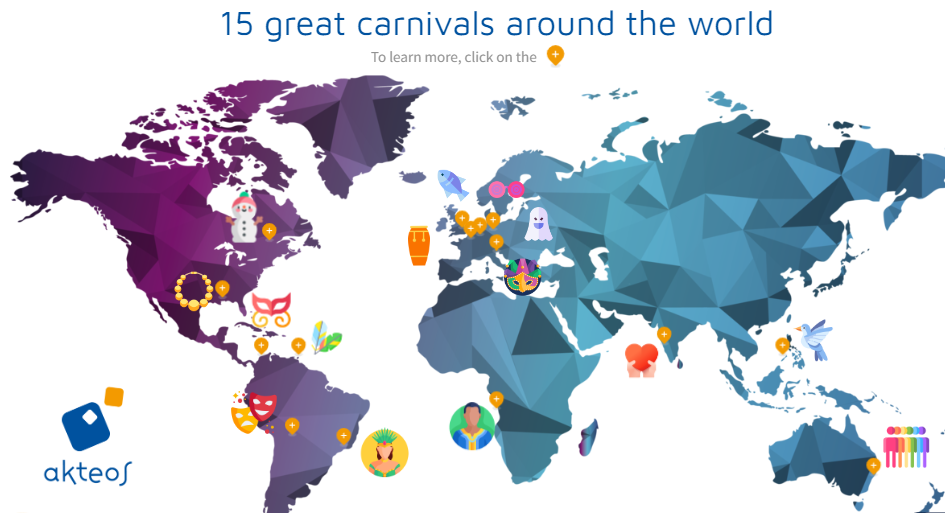15 great carnivals around the world
What are carnivals ?
Carnivals are colorful and joyful celebrations that take place in many parts of the world. They are often associated with floats, costumes, parades, music, dancing, and parties. Each country has its unique interpretation of carnival, reflecting its traditions and culture.
Quebec – Canada
In the world capital of snow, the carnival is celebrated in February* with its official mascot: the Bonhomme. White as snow, he is dressed in a red toque (Quebec woolen cap) and an arrow sash to embody the joie de vivre of Quebecers. The traditions there are also include wearing red clothes, carnival songs, and the famous Caribou (a traditional Quebec drink made of red wine and strong alcohol).
New-Orleans – USA
It is one of the oldest holidays in the United States and takes place in the weeks leading up to Ash Wednesday and the beginning of Lent. This religious festival was introduced to Louisiana in the late 17th century by the first French settlers, hence the strong presence of French culture.
During the lead-up to carnival, there are one or two parades per day. These parades are organized by secret organizations known as “Krewes” and take place on Saint Charles Avenue, Canal Street and of course the French Quarter. Traditionally, during these parades, the people on the floats throw colorful bead necklaces to the crowd.
Barranquilla – Colombia
In Colombia, Carnival is the most folkloric festival in the country and takes place in March*. Colombians and foreigners flock to this Caribbean city to attend the parades and regional dances.
The carnival of Barranquilla offers the opportunity to admire the local handicrafts expressed in all their diversity: floats, costumes, headdresses and animal masks. It is classified as an oral and intangible heritage by UNESCO.
Port of Spain – Trinidad and Tobago
On Fat Sunday in February*, the king and queen of the carnival are elected. On Monday, “J’ouvert” (Open Day), the whole city takes to the streets. Steel bands, soca and calypso are the music that gives rhythm to the party until the big Mardi Gras parade, full of glitter, bright bikinis and ostrich feathers.
Oruro – Bolivia
Oral and intangible heritage of UNESCO since 2008, the carnival of Oruro is the biggest annual cultural event of Bolivia. It takes place in February*. It is part of the Ito festival in honor of the Uru people. The first step of its development is the ceremony dedicated to the Virgen del Socavón. Then come 6 days and 6 nights of parades that gather thousands of dancers and musicians. The Bolivian carnival ends with two plays on a medieval theme.
Rio de Janeiro – Brazil
It is one of the most emblematic carnivals that usually takes place during the month of February*. On this occasion, a parade honors the best samba schools of the country that dance on colorful floats. At the end of this parade, a ranking of the best performances is established.
Notting Hill – England
It was initiated in 1966 by immigrants from the Caribbean, especially from Trinidad, who represented a large proportion of the neighborhood’s population. At that time, there were clashes between the police and young people from the immigrant community. Since then, it has become a viral multicultural event that brings together tourists from around the world and takes place the last weekend of August. Sunday and Monday are public holidays in the UK for the occasion.
Binche – Belgium
This carnival is one of the oldest in Belgium. Recognized by UNESCO as a masterpiece of the oral and intangible heritage of humanity, it runs from January* to March*. During this festival, the “Gilles” are honored. To be part of the “Gilles” you have to meet one very specific requirement in order to march in the parade: you have to be a Binchois (inhabitant of Binche).
Dunkerque – France
Since the beginning of the 19th century, the port of Dunkirk has been one of the most original carnivals in France. It takes place in February*. When the procession arrives in front of the City Hall, about 450 kilos of smoked herring (called kippers) in cellophane are thrown to the crowd by the mayor from the balcony of the building. Since 2014, the mayor also throws 20 fake French fries that entitle the bearer to free mussels and French fries in a Dunkirk restaurant. His predecessor, on the other hand, threw a plastic lobster. Whoever was lucky enough to get hold of it had to bring it back to the town hall where he was given a voucher to get a real one in a fish shop in exchange.
Cologne – Germany
It is considered by its participants to be the fifth season of the year and the most important holiday after Christmas. As tradition dictates, the carnival season officially begins on November 11 at 11:11 am and ends on Ash Wednesday – the beginning of Lent. The final celebrations last a full week. This carnival is centered on 7 main events: the opening of the carnival, Women’s Emancipation Day, the ghost parade, the school and neighborhood parade, the official parade, Mardi Gras and Ash Wednesday.
Venice – Italy
It is one of the oldest carnivals as its origin dates back to 1094. It is a social event from February* to March*, which is a symbol of fusion between the nobles and the Venetian people. Once disguised the Italians are all on the same pedestal. The most representative costume of the Venetian Carnival is undoubtedly the bauta, which consists of a large black cape (the tabarro), a black cloth headdress and a tricorn that makes the individual totally unrecognizable.
Luanda – Angola
This carnival takes place in the form of a competition. In February*, troupes of dancers come from all over the capital to parade and sing. The lyrics of the songs express the daily life of Luandans with their difficulties, their activities, their hopes, etc. It is a celebration of urban national identity and youth. The carnival, with its long preparations and rehearsals, is taken very seriously in Angola.
Goa – India
This carnival takes place every year in February* for 4 days during which no one goes to bed. It has more than 500 years of history and dates back to the time when Goa was a Portuguese colony. Over the years, many traditions have been preserved and can be experienced by participants. For example, Goa Carnival is used by many young people to declare their love and admiration for each other. Traditionally, restaurants prepare their best fish and meat dishes on carnival days. As the people of Goa use this event to clean their kitchens, everyone dines out. Restaurants are open all night during this carnival.
Makati – Philippines
In the Philippines, the big carnival which takes place in Makati in February*, is called the “Snail Carnival”. Its particularity is that its participants dress up only as animals or plants. It honors endangered species in order to remember to protect them.
Sydney – Australia
First held in 1982, the Sydney Gay and Lesbian Mardi Gras is an internationally renowned carnival that celebrates gays, lesbians, bisexuals and transsexuals. On the program, there are nearly a month of festivities from February to March, with a hundred or so events of all kinds: fairs, exhibitions, sports competitions, music, literature, and the unbeatable techno raves. This big street event ends with a fabulous parade of drag queens and exotic dancers, which then caps off in a huge party.
*Many carnivals are pre-Lenten festivities, which mean their dates vary yearly.
Are you going to participates in any of these carnivals ? Let us know in the comment section !
If you want to feel more comfortable during events around the world, contact Élysées Langues (contact@elylangues.com / 01.44.09.99.22. https://www.elysees-langues.com/)
Click here to see the interactive map, developed by our partner Akteos.


Learn a language quickly
Professional training
